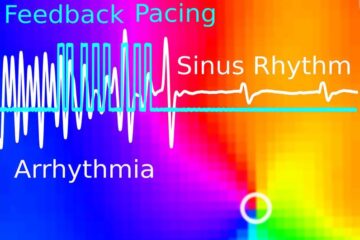Sandia Labs reports first monolithic terahertz solid-state transceiver

Sandia National Laboratories researchers have taken the first steps toward reducing the size and enhancing the functionality of devices in the terahertz (THz) frequency spectrum.
By combining a detector and laser on the same chip to make a compact receiver, the researchers rendered unnecessary the precision alignment of optical components formerly needed to couple the laser to the detector.
The new solid-state system puts to use the so-called “neglected middle child” frequency range between the microwave and infrared parts of the electromagnetic spectrum.
Terahertz radiation is of interest because some frequencies can be used to “see through” certain materials. Potentially they could be used in dental or skin cancer imaging to distinguish different tissue types. They also permit improved nondestructive testing of materials during production monitoring. Other frequencies could be used to penetrate clothing, and possibly identify chemical or biological weapons and narcotics.
Since the demonstration of semiconductor THz quantum cascade lasers (QCLs) in 2002, it has been apparent that these devices could offer unprecedented advantages in technologies used for security, communications, radar, chemical spectroscopy, radioastronomy and medical diagnostics.
Until now, however, sensitive coherent transceiver (transmitter/receiver) systems were assembled from a collection of discrete and often very large components. Similar to moving from discrete transistor to integrated chips in the microwave world and moving from optical breadboards to photonic integrated circuits in the visible/infrared world, this work represents the first steps toward reduction in size and enhanced functionality in the THz frequency spectrum.
The work, described in the current issue (June 27, 2010) of “Nature Photonics,” represents the first successful monolithic integration of a THz quantum-cascade laser and diode mixer to form a simple, but generically useful, terahertz photonic integrated circuit — a microelectronic terahertz transceiver.
With investment from Sandia's Laboratory-Directed Research and Development (LDRD) program, the lab focused on the integration of THz QCLs with sensitive, high-speed THz Schottky diode detectors, resulting in a compact, reliable solid-state platform. The transceiver embeds a small Schottky diode into the ridge waveguide cavity of a QCL, so that local-oscillator power is directly supplied to the cathode of the diode from the QCL internal fields, with no optical coupling path.
The Sandia semiconductor THz development team, headed by Michael Wanke, also included Erik Young, Christopher Nordquist, Michael Cich, Charles Fuller, John Reno, Mark Lee — all of Sandia labs — and Albert Grine of LMATA Government Services, LLC, in Albuquerque. Young recently joined Philips Lumileds Lighting Co., in San Jose, Calif.
The paper is available online at: http://dx.doi.org/10.1038/NPHOTON.2010.137 . Abstracts are available to everyone; full text only to subscribers.
Sandia National Laboratories is a multi-program laboratory operated by Sandia Corporation, a wholly owned subsidiary of Lockheed Martin Corporation, for the U.S. Department of Energy's National Nuclear Security Administration. With main facilities in Albuquerque, N.M., and Livermore, Calif., Sandia has major R&D responsibilities in national security, energy and environmental technologies, and economic competitiveness.
Sandia news media contact: Neal Singer, nsinger@sandia.gov (505) 845-7078
Sandia media relations contact: Stephanie Hobby, shobby@sandia.gov (505) 844-0948
Media Contact
More Information:
http://www.sandia.govAll latest news from the category: Physics and Astronomy
This area deals with the fundamental laws and building blocks of nature and how they interact, the properties and the behavior of matter, and research into space and time and their structures.
innovations-report provides in-depth reports and articles on subjects such as astrophysics, laser technologies, nuclear, quantum, particle and solid-state physics, nanotechnologies, planetary research and findings (Mars, Venus) and developments related to the Hubble Telescope.
Newest articles

Wildfire danger to increase due to climate change
WSL Institute for Snow and Avalanche Research (SLF) researchers expect an elevated wildfire danger in the Alpine Foreland from 2040 onwards due to changing meteorological conditions. The danger currently remains…

Advanced Brain Science Without Coding Expertise
Researchers at Helmholtz Munich and the LMU University Hospital Munich introduce DELiVR, offering a new AI-based approach to the complex task of brain cell mapping. The deep learning tool democratizes…

Gentle defibrillation for the heart
Using light pulses as a model for electrical defibrillation, Göttingen scientists developed a method to assess and modulate the heart function. The research team from the Max Planck Institute for…





















